C3-a: Developing strategies for revising with comments
To revise is to re-see, and the comments you receive from your reviewers—instructors, peers, and writing center tutors—will help you re-see your draft from your readers’ point of view. As you write for college courses, find reviewers and seek their feedback. When you ask readers for their comments, revision becomes a social experience, connecting you with the questions and concerns of readers who help you shape your work in progress.
Sometimes the comments you’ll receive are written as shorthand commands—“Be specific!”—and sometimes as questions—“What is your main point?” Such comments don’t immediately show you how to revise, but they do identify places where global and sentence-level revisions can improve your draft. Sort through the comments you receive with your purpose and audience in mind. And don’t hesitate to ask your reviewers to explain their comments if you don’t understand them.
You may also want to keep a revising and editing log, a list of the global and sentence-level concerns that come up repeatedly in your reviewers’ comments. For instance, if you frequently receive comments such as “Develop more” or “Avoid run-on sentences,” you can use these comments to help you learn specific lessons and to transfer your learning from one assignment to the next.
This section addresses common types of comments an instructor, a peer, or a tutor might offer and suggests specific strategies for revising.
THE COMMENT: Narrow Your Introduction
THE COMMENT:Narrow Your Introduction
similar comments: Unfocused intro • Too broad
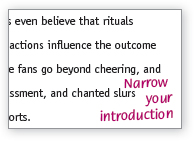
understanding the comment When readers point out that your introduction needs to be “narrowed,” the comment often signals that the beginning sentences of your essay are not specific or focused.
strategies for revising
- Reread your introduction and ask questions. Are the sentences leading to your thesis specific enough to engage readers and communicate your purpose? Do these sentences lead logically to your thesis? Do they spark your readers’ curiosity and offer them a reason to continue reading? (See C2-a.)
- Try engaging readers with a “hook” in your introduction—a question, a quotation, or a vivid example. (See C2-a.)
THE COMMENT: Unclear thesis
THE COMMENT:Unclear thesis
similar comments: Vague thesis • State your position • What is your main point?

understanding the comment When readers point out that your thesis is unclear, the comment often signals that they have a hard time identifying your essay’s main point.
strategies for revising
- Ask questions. What is the thesis, position, or main point of the draft? Can you support it with the available evidence? (See C1-c and MLA-1c.)
- Reread your entire draft. Because ideas develop as you write, you may find that your conclusion contains a clearer statement of your main point than does your working thesis. Or you may find your thesis elsewhere in your draft. (See C2-a and C2-c.)
- Try framing your thesis as an answer to a question you pose, the resolution of a problem you identify, or a position you take in a debate. And put your thesis to the “So what?” test: Why would a reader be interested in this thesis? (See C1-c.)
THE COMMENT: Develop more
THE COMMENT:Develop more
similar comments: Undeveloped • Give examples • Explain

understanding the comment When readers suggest that you “develop more,” the comment often signals that you stopped short of providing a full and detailed discussion of your idea.
strategies for revising
- Read your paragraph to a peer or a tutor and ask specific questions. What’s missing? Do readers need more background information or examples to understand your point? Do they need more evidence to be convinced? Is it clear what point you’re making with your details? (See A4-d.)
- Keep your purpose in mind. Your assignment probably asks you to do more than summarize sources or list examples and evidence. Make sure you discuss the examples and illustrations you provide and analyze your evidence. (See A4-e.)
- Think about why your main point matters to your readers. Take another look at your points and support, and answer the “So what?” question. (See C1-c.)
THE COMMENT: Be specific
THE COMMENT:Be specific
similar comments: Need examples • Evidence?

understanding the comment When readers say that you need to “be specific,” the comment often signals that you could strengthen your writing with additional details.
strategies for revising
- Reread your topic sentence to understand the focus of the paragraph. (See C5-a.)
- Ask questions. Does the paragraph contain claims that need support? Have you provided evidence—specific examples, vivid details and illustrations, statistics and facts—to help readers understand your ideas and find them persuasive? (See A4-e.)
- Interpret your evidence. Remember that details and examples don’t speak for themselves. You’ll need to show readers how evidence supports your claims. (See A1-d and MLA-3c.)
THE COMMENT: Consider opposing viewpoints
THE COMMENT:Consider opposing viewpoints
similar comments: What about the other side? • Counterargument?
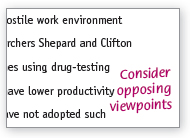
understanding the comment When readers suggest that you “consider opposing viewpoints,” the comment often signals that you need to recognize and respond to possible objections to your argument.
strategies for revising
- Read more to learn about the debates surrounding the topic. (See R1.)
- Ask questions. Are there other sides to the issue? Would a reasonable person offer an alternative explanation for the evidence or provide counterevidence? (See A3-c and A4-f.)
- Be open-minded. Although it might seem illogical to introduce opposing arguments, you’ll show your knowledge of the topic by recognizing that not everyone draws the same conclusion. (See A4-f and A4-g.)
- Introduce and counter objections with phrases like these: “Some readers might point out that . . .” or “Critics of this view argue that. . . .” (See A4-f.)
- Revise your thesis, if necessary, to account for other points of view.
THE COMMENT: Summarize less, analyze more
THE COMMENT:Summarize less, analyze more
similar comments: Too much summary • Show, don’t tell • Go deeper
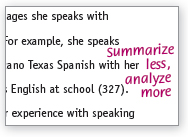
understanding the comment When readers point out that you need to include more analysis and less summary, the comment often signals that they are looking for your interpretation of the text.
strategies for revising
- Reread your paragraph and highlight the sentences that summarize. Then, in a different color, highlight the sentences that contain your analysis. (Summary describes what the text says; analysis offers a judgment or an interpretation of the text.) (See A1-c and A1-d.)
- Reread the text (or passages of the text) that you are analyzing. Pay attention to how the language and structure of the text contribute to its meaning. (See A1-a.)
- Ask questions. What strategies does the author use, and how do those strategies help convey the author’s message? What insights about the text can you share with your readers? How can you deepen your readers’ understanding of the author’s main points? (See A1-a.)
THE COMMENT: More than one point in this paragraph
THE COMMENT:More than one point in this paragraph
similar comments: Unfocused • Lacks unity • Hard to follow
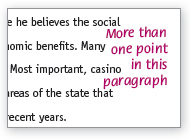
understanding the comment When readers tell you that you have “more than one point in this paragraph,” the comment often signals that not all sentences in your paragraph support the topic sentence.
strategies for revising
- Reread your paragraph and ask questions. What is the main point of the paragraph? Is there a topic sentence that signals to readers what to expect in the rest of the paragraph? Have you included sentences that perhaps belong elsewhere in your draft? (See C5-a.)
- Revisit your topic sentence. It should serve as an important sign-post for readers. Make sure that the wording of your topic sentence is precise and that you have enough evidence to support it in the paragraph. (See C5-a.)
THE COMMENT: Cite your sources
THE COMMENT:Cite your sources
similar comments: Source? • Whose words? • Document
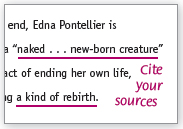
understanding the comment When readers point out that you need to “cite your sources,” the comment often signals that you need to acknowledge and give proper credit to the contributions of others.
strategies for revising
- Reread your sentence and ask questions. Have you properly acknowledged all the contributions—words, ideas, facts, or visuals—that you use as evidence? Have you given credit to the sources you quote, summarize, or paraphrase? Have you made it clear to readers how to locate the source if they want to consult it? (See MLA-2, APA-2, and CMS-2.)
- Ask your instructor which documentation style you are required to use—MLA, APA, or CMS.
- Revise by including an in-text citation for any words, ideas, facts, or visuals that you used as evidence—and by including quotation marks around any language borrowed word-for-word from a source. (See MLA-2c, APA-2c and CMS-2c.)
- Review advice on citing sources. (See MLA-4, APA-4, and CMS-4.)
Guidelines for peer reviewers
- View yourself as a coach, not a judge. Work with the writer to identify the strengths and limitations of the draft.
- Restate the writer’s thesis and main ideas. It helps the writer to know if you understand the main point of the essay.
- Where possible, give specific compliments. Vague comments (“I liked your essay”) aren’t helpful. What has the writer done well?
- Ask questions about passages that you find confusing or interesting. Doing so provides clues about where to clarify and develop the draft.
Guidelines for using reviewers’ comments
- Don’t take criticism personally. Your reader is responding to your essay, not to you.
- Pay attention to ideas that contradict your own. Responding to readers’ objections instead of dismissing them may make your essay more persuasive.
- Look for global, big-picture concerns. Focus on comments about thesis, organization, and evidence rather than commas and spelling.
- Weigh feedback carefully; sort through the comments with your goals in mind.
- Keep a revision and editing log to note the concerns that come up repeatedly in reviewers’ comments.